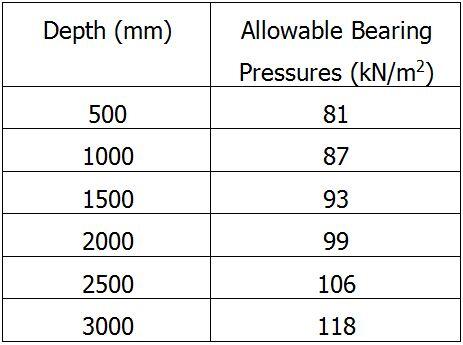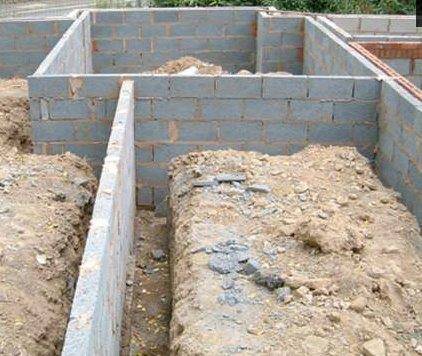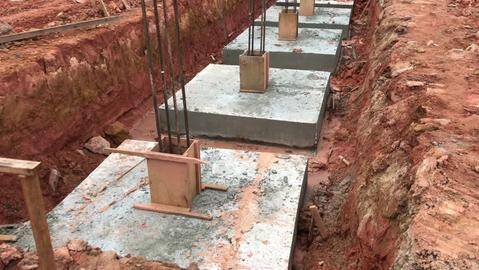Foundations are substructure elements that transmit the superstructure load of a structure to the final bearing soil layer/stratum. The depth of a foundation is an important parameter that influences the performance of the structure. There are no strict rules or direct formulas for determining the depth of a foundation, but there are important factors that must be considered before the final depth of a foundation is selected.
The first consideration in the selection of the depth of a foundation is that the foundation should be taken down to a depth where the bearing capacity of the soil is adequate to support the foundation loading without excessive settlement or shear failure. The bearing capacity of the foundation and the depth is determined from soil investigation using in-situ and/or laboratory tests.
Soil investigation report produced by a geotechnical engineer usually contains the bearing capacity of soil in a site at different depths. The selected depth and bearing capacity used for the foundation design should give an idea of the minimum depth of the foundation. A typical example is shown in the table below;

From the table above, if a bearing capacity of 87 kPa has been used for the foundation design, the minimum depth of the foundation should be 1000 mm.
Aside from bearing capacity considerations, it is very important to take the depth of foundations beyond the loose or disturbed topsoil, or soil liable to erosion by wind or flood. When a foundation is founded very close to the ground surface, erosion can lead to loss of bearing capacity no matter how strong the strata is in shear resistance.
When the conditions above are met, the major objective should then be to avoid too great a depth to the foundation level. Depending on the nature of the soil, when the excavation of the trench exceeds 1500 mm, supports may be required to keep the sides from caving in. This can cause a lot of disruption to the foundation construction and subsequently add to the cost of the foundation.
Where possible or applicable, the base of a shallow foundation should be kept above the groundwater level in order to avoid the costs of groundwater control and possible instability of the soil due to the seepage of water into the bottom of the excavation. According to Tomlinson et al (1989), it is usually more economical to adopt wide foundations at a comparatively low bearing pressure, or even to adopt the alternative of piled foundations, than to excavate below groundwater level in a water-bearing gravel, sand or silt.
Apart from the considerations of allowable bearing capacity, it is important to extend shallow foundations in clays beyond the soil stratum that is subject to the influences of ground movement caused by swelling and shrinkage, vegetation, frost action, and other effects. Consideration should be given to the stability of shallow foundations on stepped or sloping ground.
The anticipated loading on a foundation can also influence the depth of the foundation. Foundations subjected to high lateral loads and overturning moment should be founded at greater depths where the depth of the foundation and surcharge can improve the factor of safety against overturning and sliding.
Rankine’s formula can be used to estimate the depth of a shallow foundation. However, the answer gotten from the formula is rarely used because of its lack of practical significance. Rankine’s formula for the depth of a shallow foundation is given by;
Df = (qa/Ƴ) × [(1 – sinØ)/(1 + sinØ)]2
Where;
qa = allowable bearing capacity
Ƴ = unit weight of soil
Ø = angle of repose or shearing resistance of soil

For pad and strip foundations, it is usual to provide a minimum depth of 500 mm as a safeguard against minor soil erosion, the burrowing of insects or animals, heave, and minor local excavations and soil cultivation. It is important to note that this minimum depth is inadequate for foundations on shrinkable clays where swelling and shrinkage of the soil due to seasonal moisture changes may cause appreciable movements of foundations.
A depth of 900 mm to 1000 m is regarded as a minimum at which some seasonal movement will occur but is unlikely to be of a magnitude sufficient to cause damage to the superstructure or ordinary building finishes.
For most duplexes constructed in Nigeria where the bearing capacity of the soil is greater than 100 kN/m2 at shallow depths, a depth of 900 mm to 1200 mm is usually adequate for separate column bases.
References
Tomlinson M. J. (1989): “Foundations Design” in Civil Engineer’s Reference (L. S. Blake eds). Butterworth-Heinemann 1989











In the above formula of minimum depth of foundation the allowable bearing capacity is stated. In the conventional Terzaghi bearing capacity equation, the ultimate bearing capacity of soil is stated in terms of depth of foundation, that is we have two unknown parameters, df and qu. so, if one parameter is not determined how we can use apply the above formula to determine the minimum depth of foundation? it is applicable for presumptive bearing capacity which is available on different codes for different types of soil.
Good day sir,
From the report above, taking into consideration that I want to use raft foundation, does this mean, I will have to dig >= 1m below the natural ground level of the site to achieve 87 KN/m2 before placing the footing of my raft beam?
In practice, folks just go to construction site to place raft beam on the natural site level, and in most cases, fill first, compact, and start the raft beam.
What is the best practice around this.
“considering that in some cases water table level might high and digging below certain depth will cause the water to escape.”
Thanks